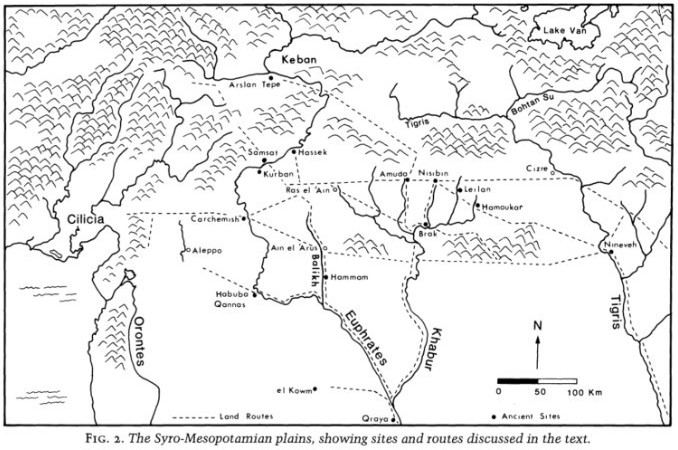|
Other Archaeological Sites / The Neolithic of the Levant (500 Page Book Online)
The Uruk Expansion: Cross Cultural Exchange in Early Mesopotamian Civilization
Excerpts and Definitions and Addendums: ProofRead and Updated May 27th 2019
Thus the origins of Mesopotamian civilization can only be understood within a framework in which cross cultural exchange occupies a prominent position ... The expansion was an attempt to control the critical lines of communication through which flowed needed resources. This expansion took a variety of forms ranging from trade contacts and networks and/or military expeditions and raids to territorial annexation and (*)provinces. Contacts between communities in the northern periphery and the alluvial lowlands were based on the flow from highland sources of raw materials such as copper -- timber -- limestone -- marble -- flint -- basalt -- obsidian -- bitumen -- gold -- silver -- lead -- lapis lazuli etcetera; and occasionally dependent labor (slaves and prisoners of war) either under duress in the form of tribute or plunder or, more commonly, in return for labor intensive processed and semi-processed goods. These principal resources exported from Mesopotamia were: surplus grain -- leather products -- dried fish -- dates and textiles.
ENCLAVES: ... Three Uruk enclaves have been identified along the great bend of the Euphrates: Samsat and Carchemish in southeastern Turkey and Habuba Kabira (Tell Qannas) in northeastern Syria [See Map Above]. Along the Euphrates Samsat controls the main ford on the route from the Kurdish Anti-Taurus (Commagene) into northern Mesopotamia via Urfa -- Harran and the upper reaches of the Upper Khabur (Amuda and Nisibin). Carchemish, another of the historical Euphrates fords, connects the northern Syrian steppe and the environs of the fertile Aleppo plain with the northern Mesopotamian plains east of the river and ultimately the Tigris via the middle reaches of the Balikh (Ain el Arus) and the Upper Khabur (Ras el Ain). And finally the Tabqa Dam area in the lower corner of the great bend of the Euphrates represents the last major ford before the onset of the Syrian Desert -- the traditional terminus of overland caravans alongside the Euphrates before cutting across directly west in the direction of Hamah on the Orontes River or alternatively northwest across the Syrian steppe in the direction of Aleppo and the Amanus (cedar mountains) in Lebanon and ultimately Cilicia in Anatolia. The location of Mesopotamian enclaves along the Upper Khabur and Upper Tigris basins is also best understood in terms of a strategy for ensuring control of overland routes. Tell Brak is well situated to control overland north-south traffic from the Euphrates alongside the Khabur. Of equal importance however it lies at the juncture of the Jaghjagh and an important classical route that crosses the Euphrates at either Zeugma or Carchemish and cuts across Ras el Ain before heading towards the Tigris via the Jebel Sinjar. The Nineveh / Mosul area was historically the most important of the Upper Tigris fords and Nineveh is situated at the intersection of the river and several of the main overland routes from the Euphrates. Moreover traditionally the Tigris was also an important thoroughfare for downstream navigation and the convergence of complementary overland and water-born routes at Nineveh makes the site an ideal transshipment point where the overland traffic from the west could be easily and cheaply funneled south downstream on the river. There is no need to presume that all the enclaves were established as part of a single coherent effort. On the contrary the long sequence of Uruk deposits uncovered at sites such as Brak -- Nineveh and Carchemish contrast starkly with the more explosive growth of the Habuba/Qannas enclave which thus represents the culmination of a long organic process of expansion ...
(*) province: a country or region brought under the control of a foreign government ... |

